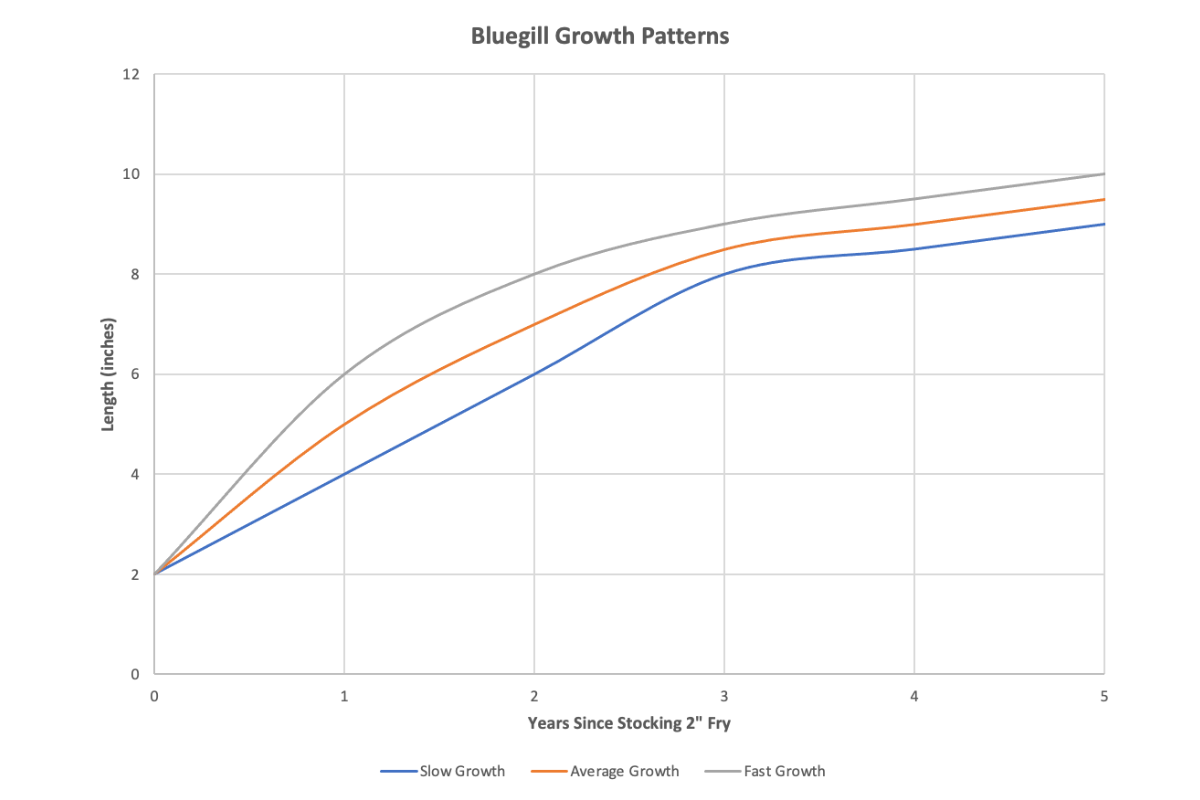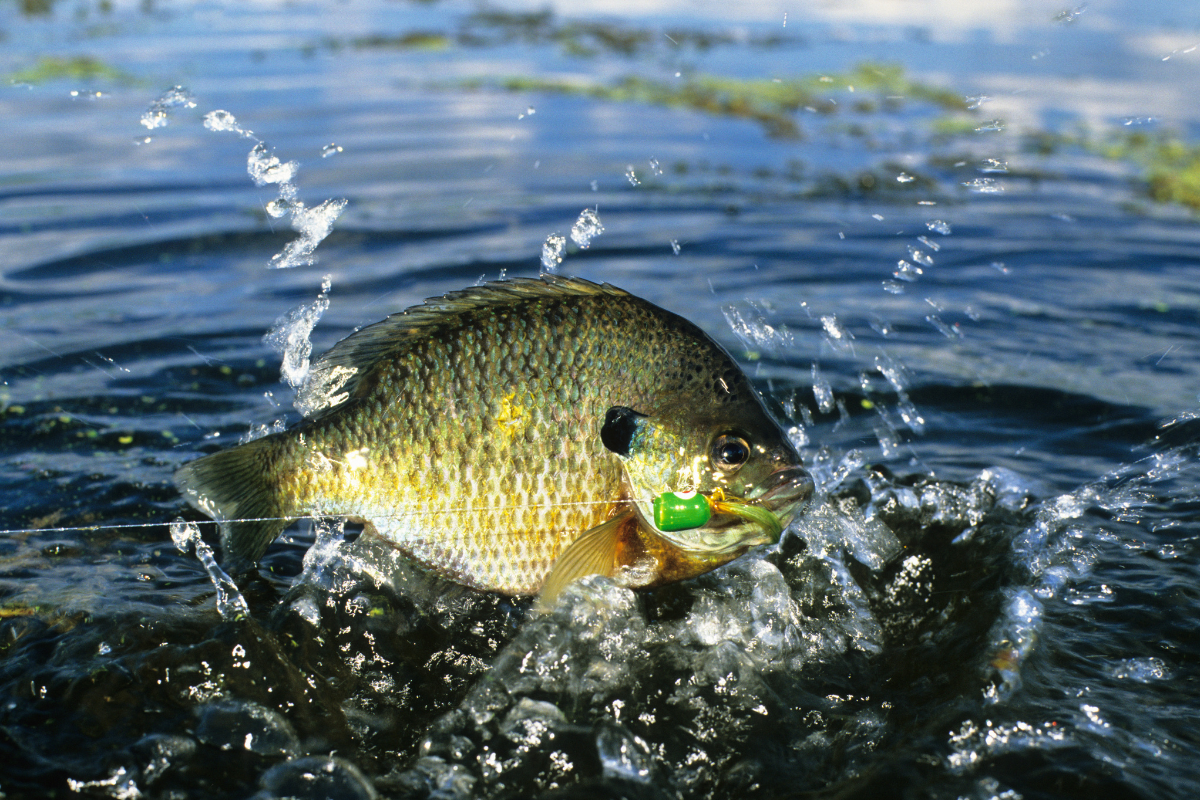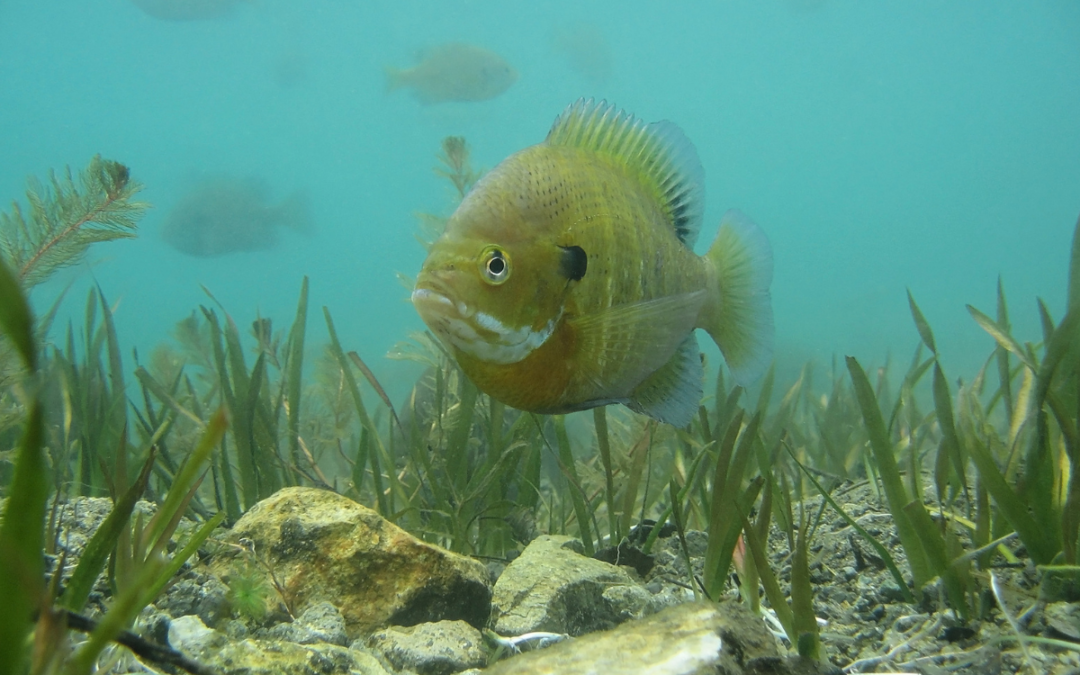A Healthy Bluegill Population Is a Must!
A healthy bluegill population is a key component to any productive pond. Even if you’re only fishing for largemouth bass, you need a healthy bluegill population for those bass to eat. But most pond owners enjoy catching (and eating) bluegill. Either way, bluegill populations need to be managed just as much as largemouth bass populations.
Bluegill will grow faster in southern ponds as opposed to northern ponds. This is simply based on the length of the warm season. When water temperatures stay warmer for longer, the fish are feeding more and growing more as a result. Spawning events will also tend to be more frequent in southern states due to warmer water temperatures over a longer period of time.
A well-managed pond should have 9″ bluegill at least six years after stocking 1-3″ fry. The rate of growth will depend on several factors, which we’ll discuss below. The more ideal the conditions, the faster they’ll grow. The figure below shows the difference between slow, average, and fast growth over a 5 year time period after stocking 2″ bluegill fry. These numbers aren’t exact and will vary from pond to pond, but it gives you an idea of what to expect after stocking bluegill in your pond.

Food for Bluegill
Bluegill growth will be a function of how much food and how much space they have. We always recommend installing a fish feeder when stocking bluegill in a new or established pond. We also recommend using high-quality, pelleted fish food that can significantly increase the growth of a young bluegill population. High-quality fish food like Cargill or Purina is worth every penny and you’ll see much faster growth compared to using cheap fish food.
Closely monitor your fish feeder after installation to make sure you’re feeding the right amount each day. Overfeeding not only wastes fish food, but it can create an accumulation of fish food at the bottom of your pond. Our rule of thumb is to only feed your fish as much as they can eat in 10 minutes. Set your feeder to a low rate and watch the fish feed. If they’re eating all the food in 10 minutes, you may want to increase the amount. If they’re not consuming all the food, decrease the amount of food per feeding.
In addition to having a solid fish feeding program, you’ll want to ensure your pond water is fertile. We find the largest and fattest bluegill in fertile ponds that have a green tint to the water. Clear water is an indication of low phytoplankton populations. Phytoplankton form the base of the pond food chain and are essential to pond food web dynamics. If your pond doesn’t receive nutrients from agricultural runoff, you’ll probably need to add fertilizer to boost your phytoplankton populations.

Artificial Selection
If bluegill become overcrowded in a pond, individual fish growth will be stunted and fish will not be fat and healthy. As a result, it’s important to have some type of “selection” to keep population densities from becoming too high. This can be done via artificial selection (fishing), natural selection (predators), or both.
Once a bluegill population has established several years after stocking, individuals should be removed to prevent overcrowding. Don’t worry about overfishing and removing too many bluegill. Removing individuals from the population keeps the gene pool diverse and prevents stunted populations.
In a fertile pond, you can harvest up to 160 lbs of bluegill per acre per year. We recommend harvesting the larger individuals that are 6-8″ long. When harvesting these fish, it’s not a bad idea to weigh a few to check their relative weight. A 6″ bluegill should weigh 0.15 lbs and an 8″ bluegill should weight 0.37 lbs. If your 6″ and 8″ bluegill weigh more than this, your pond is doing great. If they weigh less than those standard weights, there’s room for improvement.
Natural Selection
Predators like largemouth bass will also help to keep the bluegill population in check. If you stock a pond with only bluegill and no predators, you’re guaranteed to see the population eventually stunt. You need this natural selection by predators to remove the weaker individuals and promote strong genetics in the bluegill population.
When stocking a new pond, we recommend not introducing predators until one year after stocking bluegill. This gives the bluegill population time to spawn at least once (but hopefully more than once) before predators are introduced. If you’re stocking bluegill in an established pond with predators present, you’ll definitely want to consider stocking larger fish. Fry bluegill will have a very high mortality rate in a pond with an established bass population.
Let Up Help Improve Your Pond!
If you’re in the south GA or north FL areas, we’ll be glad to help with your new pond or an existing pond that is struggling to maintain healthy fish populations. Just complete this form and we’ll contact you to schedule a time to meet. We look forward to turning your pond into a productive fishery for years to come!

